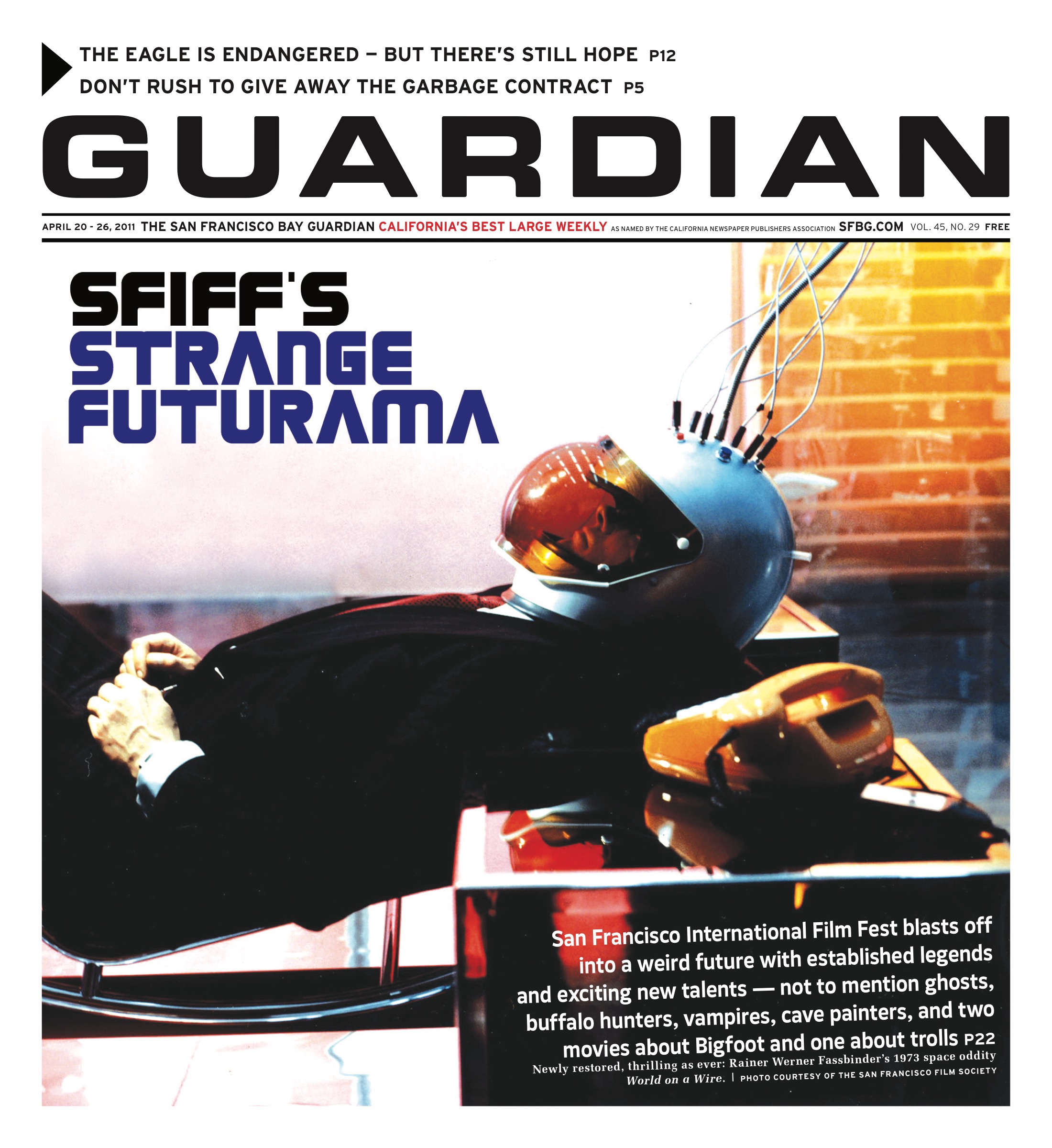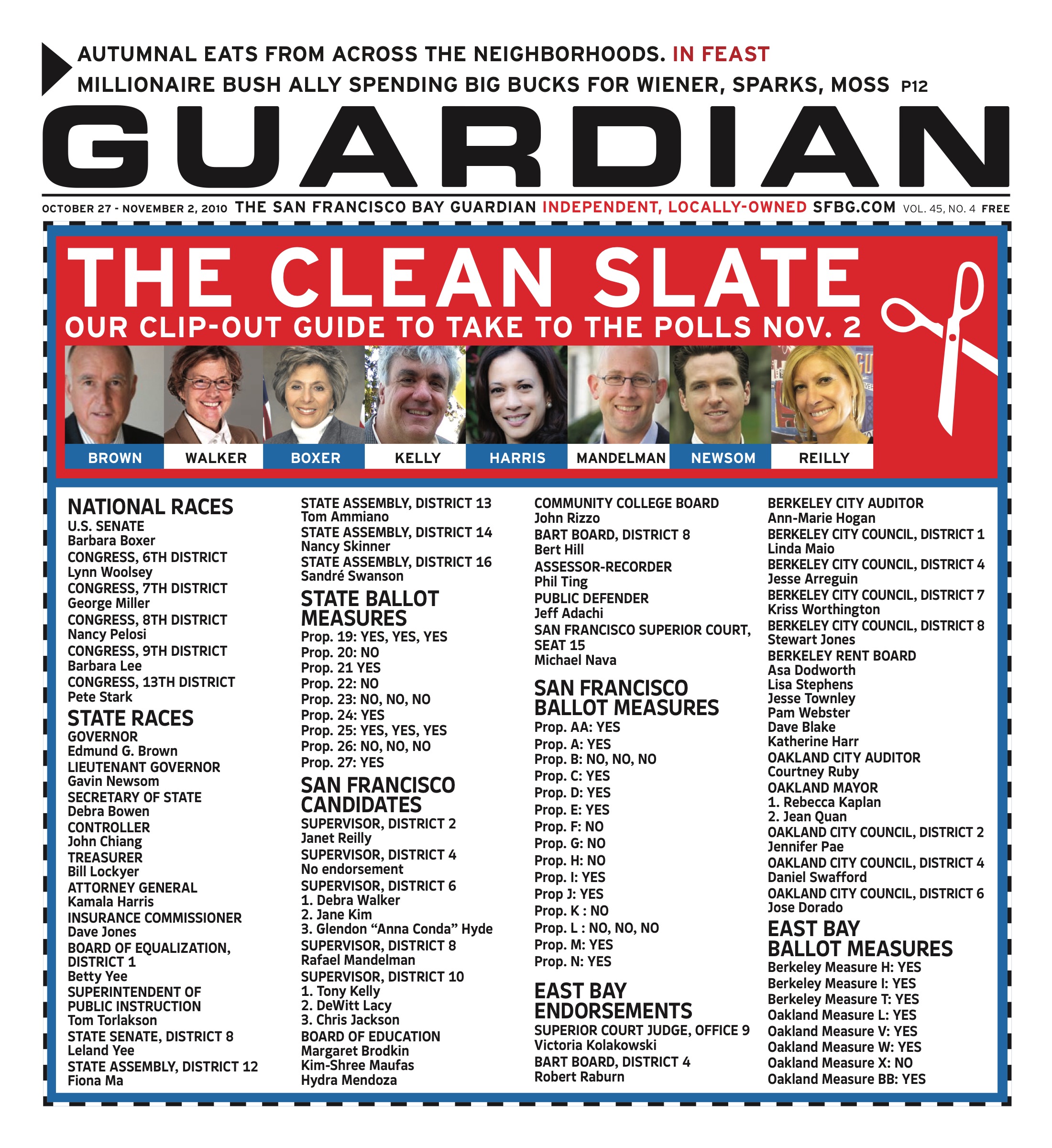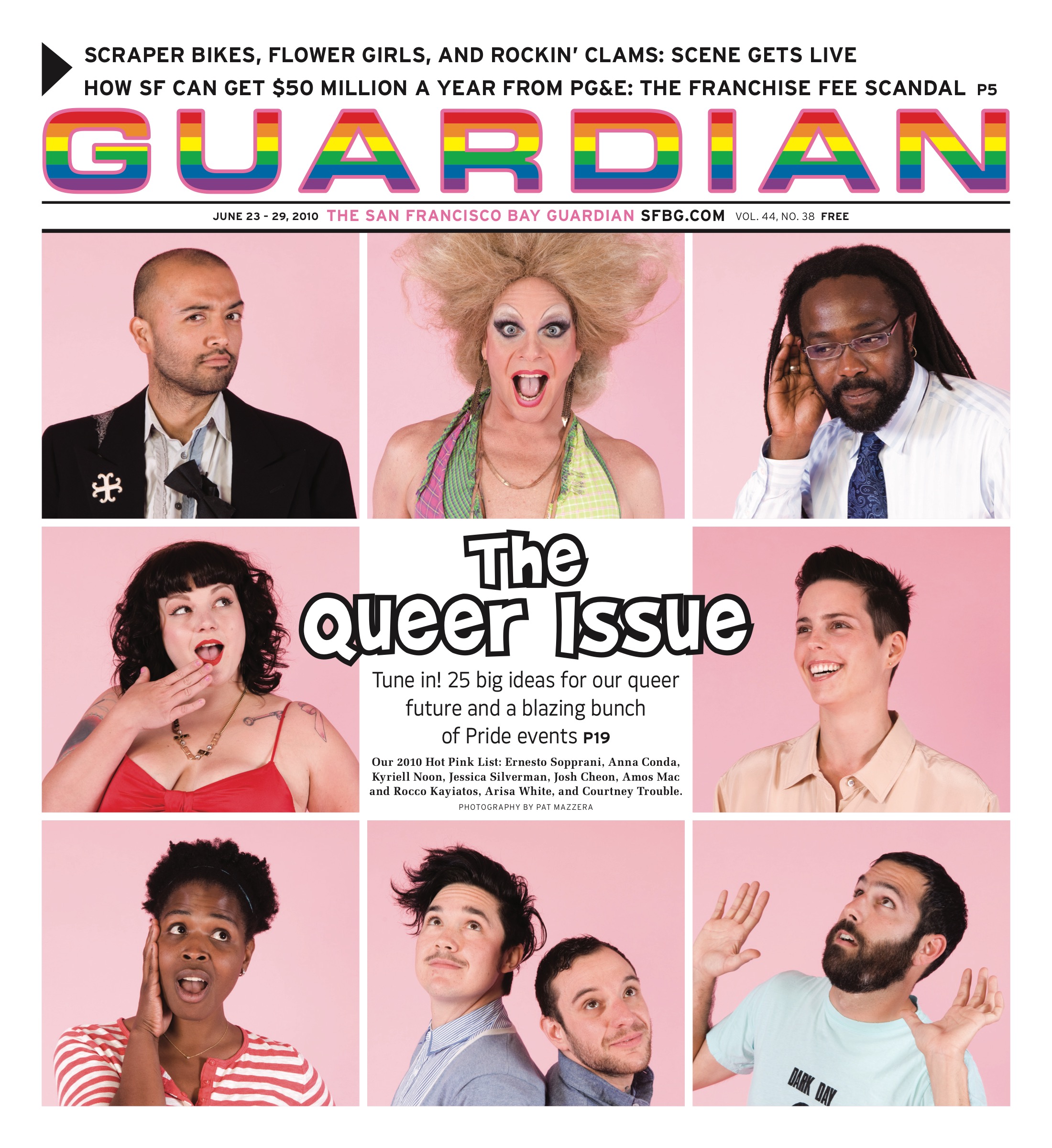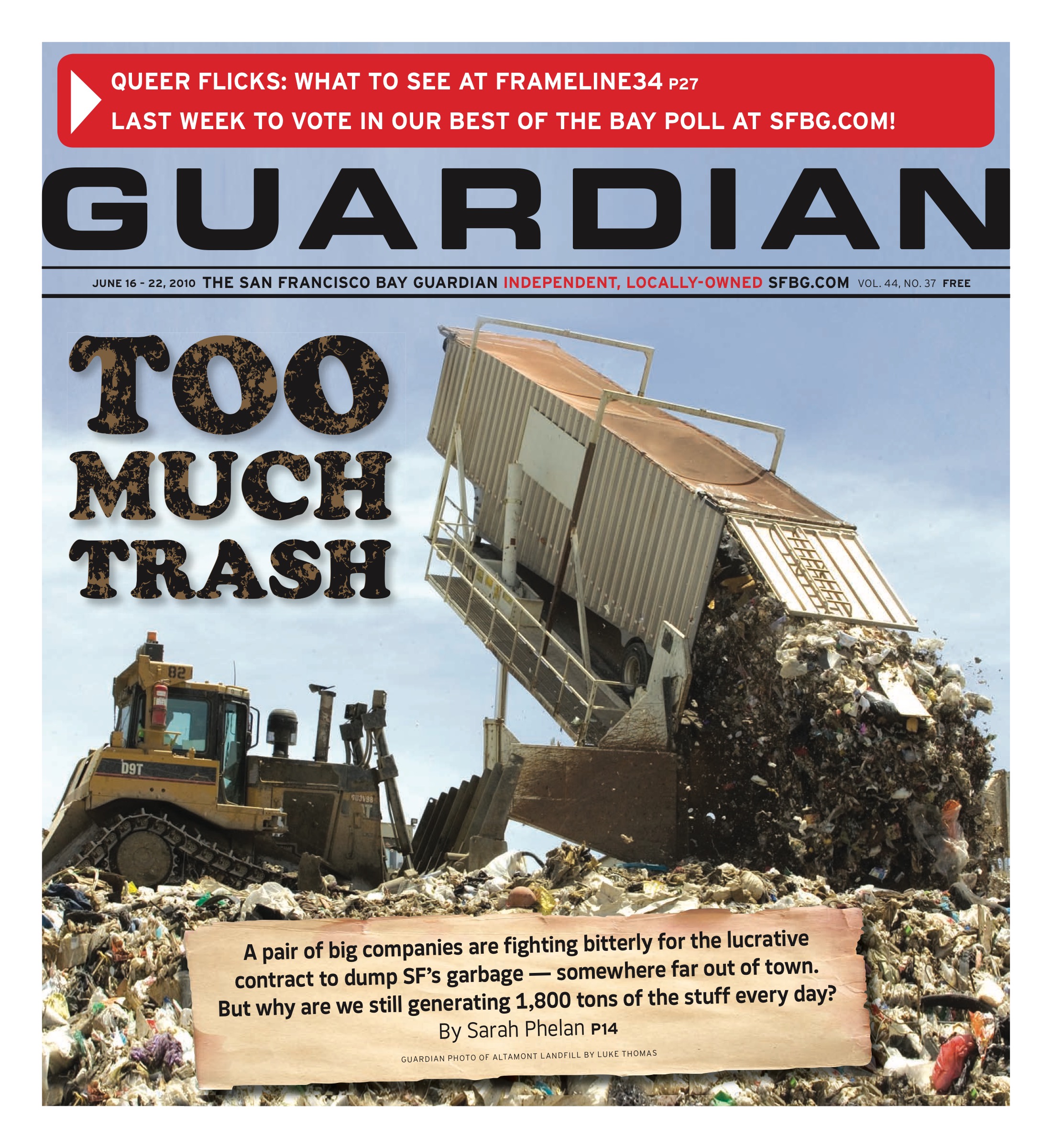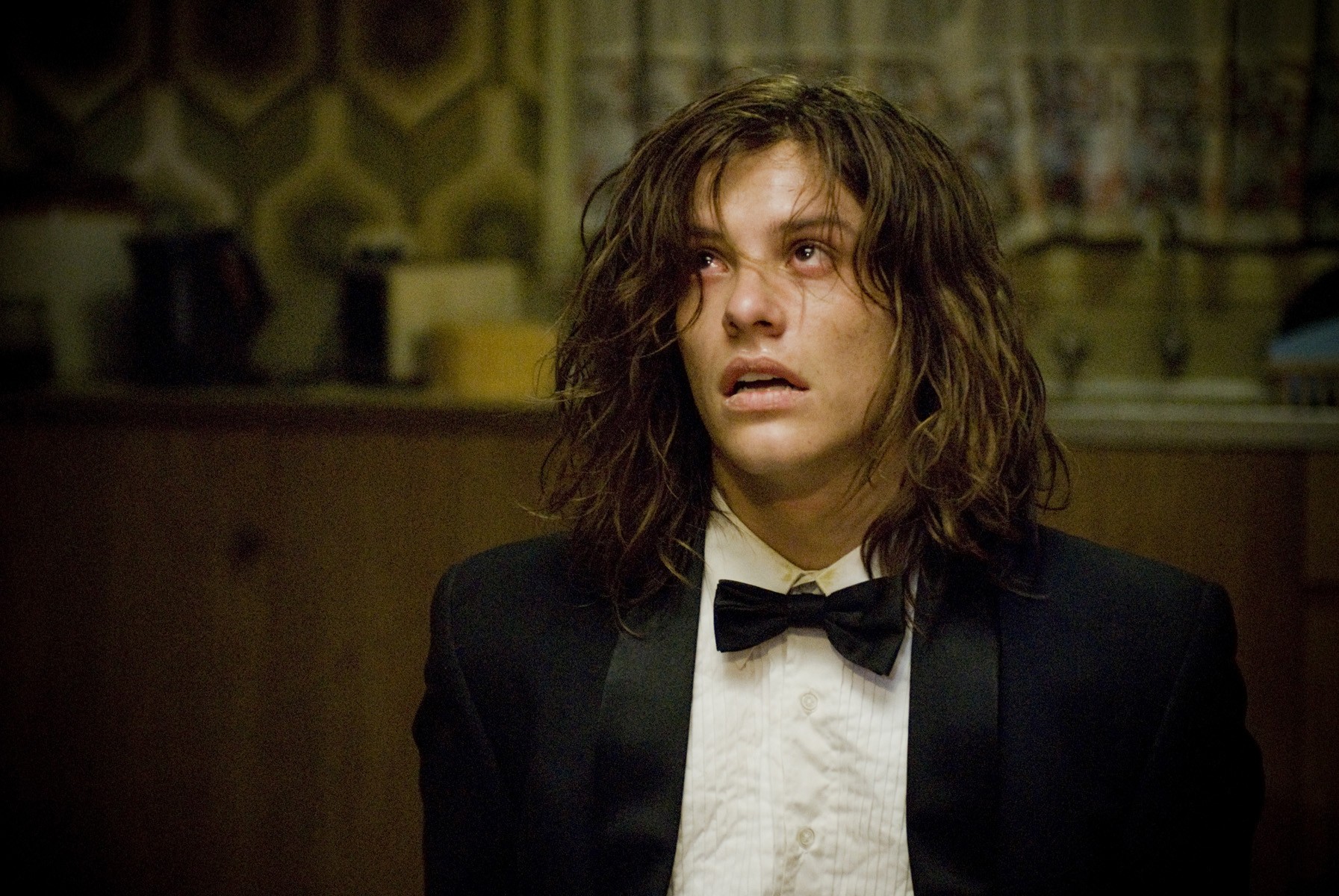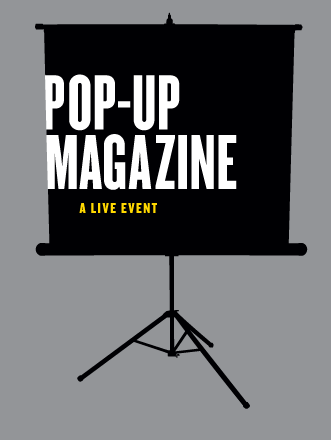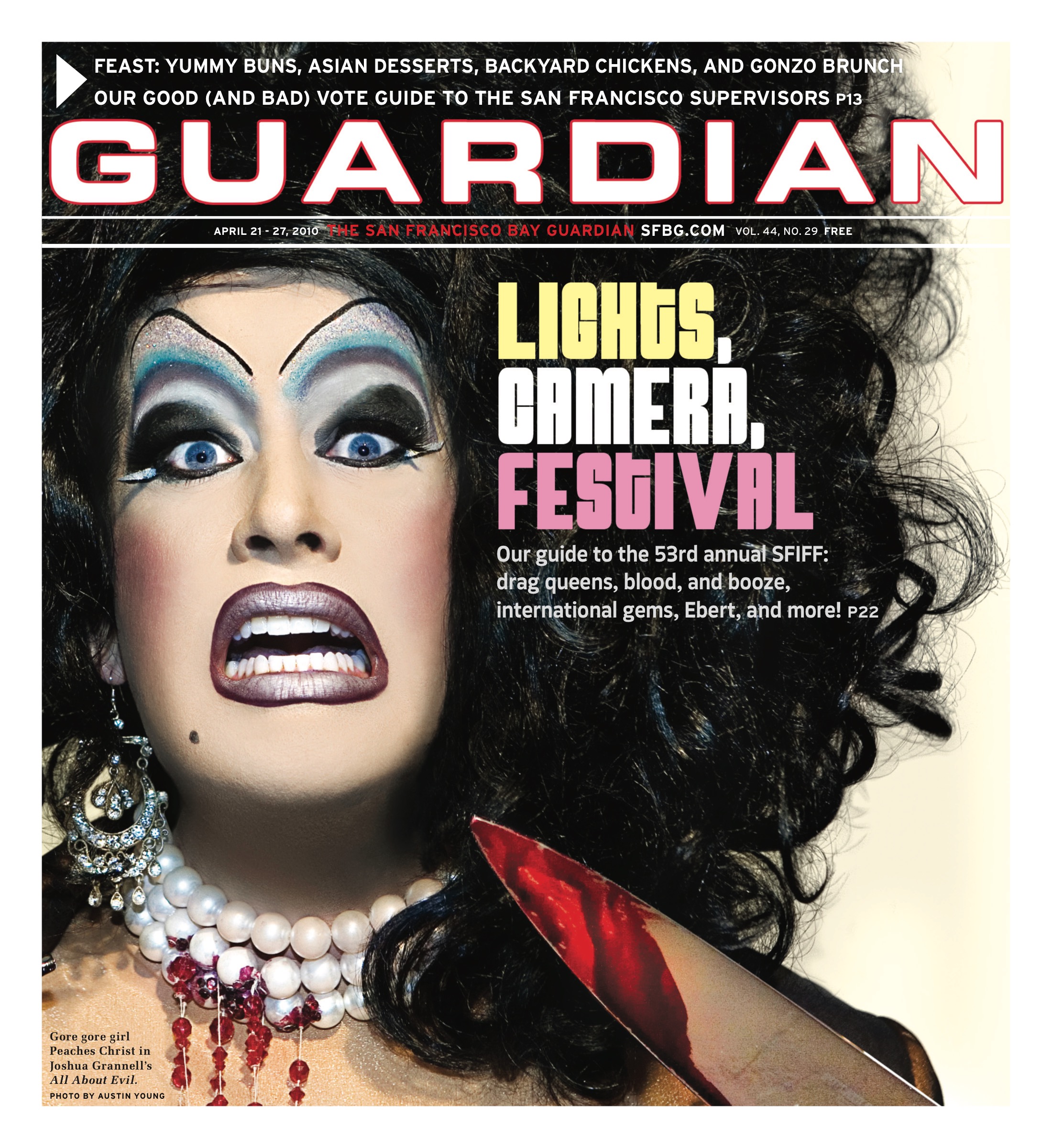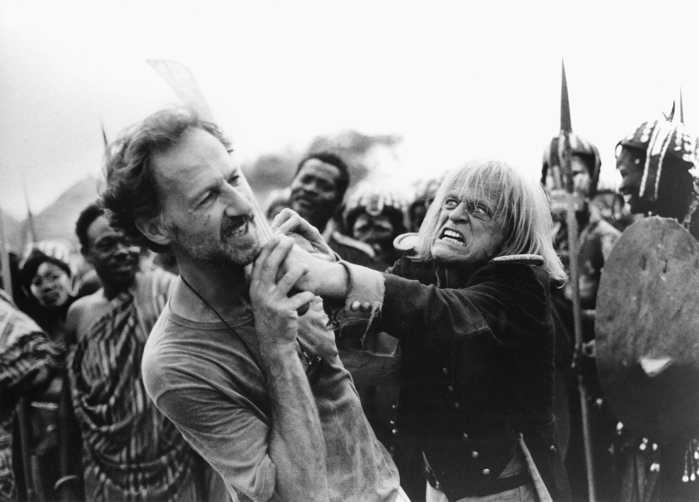Film listings are edited by Cheryl Eddy. Reviewers are Kimberly Chun, Michelle Devereaux, Max Goldberg, Dennis Harvey, Johnny Ray Huston, Erik Morse, Louis Peitzman, Lynn Rapoport, Ben Richardson, and Matt Sussman. The film intern is Peter Galvin. For rep house showtimes, see Rep Clock. For first-run showtimes, see Movie Guide.
SAN FRANCISCO INTERNATIONAL FILM FESTIVAL
The 53rd San Francisco International Film Festival runs April 22-May 6 at Sundance Kabuki Cinemas, 1881 Post, SF; Clay Theatre, 2261 Fillmore, SF; Castro Theatre, 429 Castro, SF; and the Pacific Film Archive, 2575 Bancroft, SF. Tickets (most shows $12.50) are available by calling (925) 866-9559 or by visiting www.sffs.org. All times p.m. unless otherwise noted.
THURS/22
Castro Micmacs 7.
FRI/23
Kabuki The Man Who Will Come 3:30. Moscow 4. Constantin and Elena 4:15. The White Meadows 6:30. Simonal: No One Knows How Tough It Was 6:45. Son of Babylon 7. "POV Award: Don Hertzfeldt: Life, Death, and Very Large Utensils" 7:30. Frontier Blues 8:45. Nymph 9. Around a Small Mountain 9:30. Cargo 10.
PFA Littlerock 6:30. Cold Weather 8:45.
SAT/24
Kabuki "Talkin’ Bout My Generation" (shorts program) 12:30. A Brand New Life 1:45. Rejoice and Shout 2. "A Conversation with Callie Khouri" (shorts program) 2:30. My Dog Tulip 2. Imperfect Unions 3:15. Around a Small Mountain 4:15. Nymph 4:30. "A Conversation with T Bone Burnett" (shorts program) 6. Between Two Worlds 6:15. Transcending Lynch 6:30. Moscow 6:45. Cracks 8. Littlerock 9. "Pirate Utopias" (shorts program) 9:15. The White Meadows 9:30. The Violent Kind 11.
PFA Way of Nature 2. Shirley Adams 4:15. The Famous and the Dead 6:40. "Something Like a Dream" (shorts program) 8:45.
SUN/25
Kabuki "Flights of Fancy" 10am. Constantin and Elena noon. Coco Chanel and Igor Stravinsky 12:30. Empire of Silver 12:45. "Solitude Standing" (shorts program) 12:45. Domain 3. Frontier Blues 3:15. Way of Nature 3:45. "State of Cinema Address: Walter Murch" 4. The Man Who Will Come 5:45. My Dog Tulip 6. Cold Weather 6:15. "The High Line" (shorts program) 6:30. Everyone Else 8:45. Between Two Worlds 9. Cracks 9:15. "Utopia in Four Movements" 9:30.
PFA Mugabe and the White African 2. Pianomania 4. Northless 6. The White Meadows 8.
MON/26
Kabuki Way of Nature 1. Between Two Worlds 3:15. The Man Who Will Come 3:30. Littlerock 3:45. 13-18: The Noise and the Fury 4:30. Morning 6:15. Cargo 6:30. Soul Kitchen 6:45. Port of Memory 7:15. Transcending Lynch 9. Coco Chanel and Igor Stravinsky 9:15. "A Drunken Evening With Derek Waters and Wholphin" 9:30. Wake in Fright (Outback) 9:45.
PFA The Peddler 6:30. Father of My Children 8:15.
TUES/27
Kabuki Transcending Lynch 12:40. Son of Babylon 12:45. Frontier Blues 2. Shirley Adams 3:15. Everyone Else 3:30. My Dog Tulip 4:15. Gainsbourg (Je T’Aime … Moi Non Plus) 6. Domain 6:15. Constantin and Elena 6:45. "Something Like a Dream" (shorts program) 7. Moscow 9. Port of Memory 9:30. Vengeance 9:45. The Violent Kind 9:45.
PFA White Material 6:30. The Oath 8:40.
OPENING
The Back-Up Plan The good thing is, once this opens you won’t have to see its wretched trailer any more. (1:40) Presidio.
The Harimaya Bridge The Harimaya Bridge might be the first film I’ve seen that portrays the American-Japanese culture clash so beloved by stateside filmmakers (see: 2003’s Lost in Translation) from the viewpoint of an African American man in Japan. The debut feature for short-film director Aaron Woolfolk, Bridge follows a retired man who travels to Japan after the death of his estranged son, with intentions to retrieve his son’s paintings for an art show. Likely based on Woolfolk’s personal experiences living in Japan, The Harimaya Bridge has both the look and feel of a short, an attribute that makes the otherwise agreeable film seem much too long and drawn-out. Or maybe, all along Woolfolk intended to replicate the dour melodrama and often glacial pacing of popular Japanese film. Meta-filmmaking? (2:00) Stonestown. (Galvin)
The Losers Jeffrey Dean Morgan, Zoe Saldana, and Chris Evans star in this action comedy. (1:38) California.
*Mid-August Lunch Gianni Di Gregorio’s loose, engaging comedy is about an aging bachelor still living with his ancient mum in their Rome flat. When his landlord offers to forgive some debts in return for briefly taking in his own elderly ma, Gianni (played by the director himself) soon finds himself in cat-herding charge of no less than five old ladies who delight in one another’s company while running him ragged. Gomorrah (2008) screenwriter Di Gregorio used nonprofessionals to play those parts in this semi improvised miniature, which is as light and flavorful as a first course of prosciutto and mozzarella. It’s a solid addition to the canon of palate-pleasing culinary flicks such as Big Night (1996) and Babette’s Feast (1987), as opposed to the repulsive ones like Super Size Me (2004) or Monty Python’s The Meaning of Life (1983). (1:15) Clay, Shattuck. (Harvey)
No One Knows About Persian Cats Playing themselves more or less (pretty stiffly), Negar Shaghaghi and Ashkan Koshanejad are Iranian indie rockers hoping to play a concert in London. But visas are hard to come by, and their other band members have quit; anyone drafted to replace them is likely to need expensive forged passports or other documents as well. Introduced to motormouthed hustler, illegal DVD dealer, and music fan Nader (a manic Hamed Behdad, the only professional actor here), they pin their hopes on his ability to make all necessary arrangements. Meanwhile he takes them around Tehran so they can meet fellow musicians and we can hear a variety of mostly underground sounds, from speed metal to rap to traditional folk. These songs are accompanied by music video-like montages of contemporary urban life. The real-life bands in question are, onscreen and off, continually dealing with the threat of jail, lost practice spaces, neighbors calling cops, etc. That aside, many of them look and act like twentysomething hipsters anywhere, complete with wall posters of St. Kurt and Brando. Filmed without permits or much hope of public screenings at home, the latest from Kurdish director Bahman Ghobadi (2000’s A Time for Drunken Horses, 2004’s Turtles Can Fly) is an almost documentary — based on real events, locations and people — allowing just enough fictive leeway so hopefully those involved won’t get arrested for participating. As narrative, it’s loosely structured at best and pretty ineffectual in its few stabs at actual drama. But it’s also the sort of movie that needn’t be very good to be important as document and political statement. As for the music, it’s sometimes very good, sometimes too derivative or poorly sung to be interesting — the worst offender being Ghobadi himself, whose tone-deaf bray turns one bluesy number into a joke he’s clearly not in on. (1:46) Opera Plaza. (Harvey)
Oceans In a bit of clever marketing, this nature film opens on Earth Day. (1:40) Shattuck.
The Secret in Their Eyes This legal thriller from Argentina just won the Best Foreign Language Film Oscar. (2:07) Albany, Embarcadero.
What Girls Want Takashi Shimizu (director of both the 2000 Japanese and 2002 American versions of The Grudge) compiled this ominbus film, featuring six stories about women made by different directors. (1:46) Four Star.
ONGOING
Alice in Wonderland Tim Burton’s take on the classic children’s tale met my mediocre expectations exactly, given its months of pre-release hype (in the film world, fashion magazines, and even Sephora, for the love of brightly-colored eyeshadows). Most folks over a certain age will already know the story, and much of the dialogue, before the lights go down and the 3-D glasses go on; it’s up to Burton and his all-star cast (including numerous big-name actors providing voices for animated characters) to make the tale seem newly enthralling. The visuals are nearly as striking as the CG, with Helena Bonham Carter’s big-headed Red Queen a particularly marvelous human-computer creation. But Wonderland suffers from the style-over-substance dilemma that’s plagued Burton before; all that spooky-pretty whimsy can’t disguise the film’s fairly tepid script. Teenage Alice (Mia Wasikowska) displaying girl-power tendencies is a nice, if not surprising, touch, but Johnny Depp’s grating take on the Mad Hatter will please only those who were able to stomach his interpretation of Willy Wonka. (1:48) 1000 Van Ness, SF Center. (Eddy)
*Breaking Upwards The words no one ever wants to hear in bed — "Just
come. Really honey, it’s fine" — currently defining their sex life, native New Yorkers and Greenwich Village cohabiters decide to cure relationship torpor by "taking days off" from each other. This entails Daryl (Daryl Wein) moving back in with his parents three days a week, so he and Zoe (Zoe Lister Jones) can more effectively avoid all contact with each other, including phone calls. They are free to "see" other people, which for Zoe encompasses a sexy fellow actor (Pablo Schreiber) whose notions of character exploration easily extend to seducing his stage partner. Aspiring writer Daryl has his own temptations, notably two played by La Chanze and Olivia Thirlby. The queasiness of being in a committed relationship that seems to get less committed with every day "off" isn’t helped by our protagonists’ exasperating mothers, flipsides to the same wooden nickel: hers (Andrea Martin) is a wellspring of self-absorbsion and insensitivity passing as frankness, while his (Julie White) is a compulsive meddler whose ever-more-left-field opinions are like a form of maternal
Tourette syndrome ("Why can’t you be gay like your brother?"). Wein and Lister Jones co-wrote the screenplay with Peter Duchan, basing it on a dicey patch in their real-life relationship. Yet Breaking Upwards isn’t quasi-verite self-indulgence but a prickly, confident, well-observed Manhattan romantic comedy in the tradition of Annie Hall (1977). It’s a good date movie for those who can’t quite identify with Jennifer Aniston or Matthew McConaughey, whose hair and makeup expenses alone for a couple days’ shooting probably run higher than director Wein’s first-narrative-feature budget of a purported $15,000. (1:28) Lumiere. (Harvey)
*Breath Made Visible Ruedi Gerber’s documentary throws a sympathetic and fascinating light on the work of dance pioneer Anna Halprin. Weaving on-camera interviews with former collaborators, family members, and Halprin herself into excerpts from current and past work suggests decades and decades thoughtfully lived by an artist who had the guts to be herself. Again and again the camera returns to the now legendary The Deck, which husband and landscape architect Lawrence Halprin built so she could do her work while their children were growing. One of this film’s loveliest aspects is to see the deck changing just as Halprin does. Wisconsin-raised and East Coast-oriented, her moving to the California of the 1940s had isolated her from mainstream dance influences. But it also had opened vistas — to nature and through nature into herself — that she might not have able to achieve otherwise. The film may be conventionally structured but what emerges is a portrait of an anything but conventional woman, artist and thinker. (1:20) Smith Rafael. (Rita Felciano)
The Bounty Hunter There’s a real feeling of impotence in reviewing a movie whose ad was pasted on the side of the bus you took to the screening. This thing is determined to be seen, and that’s a true shame. Those who heed the call of the ubiquitous marketing campaign will have to sit through a dull parade of contrivances concerning a bounty hunter (Gerard Butler) whose latest catch is his court-skipping ex-wife (Jennifer Aniston). She’s a hotshot city journalist who’s forced to continue her investigation of a police cover-up while handcuffed to a car door and bickering with her old flame. The trajectory of the plot is obvious enough, but there’s so little chemistry between the two actors that the inevitable reconciliation practically constitutes a twist ending. Aniston saw fit not to whine her way through this role, which is something, but nothing nearly as complimentary can be said about Butler. He emotes in lurches, with the presence of a guy who’s not sure acting is the right direction for his life but still really wants to give it a go. If "This. Is. Sparta!" weren’t burned into my brain I would swear the man had never been in front of a camera before. (1:50) SF Center. (Jason Shamai)
*City Island The Rizzo family of City Island, N.Y. — a tiny atoll associated historically with fishing and jurisdictionally with the Bronx — have reached a state where their primary interactions consist of sniping, yelling, and storming out of rooms. These storm clouds operate as cover for the secrets they’re all busy keeping from one another. Correctional officer Vince (Andy Garcia) pretends he’s got frequent poker nights so he can skulk off to his true shameful indulgence: a Manhattan acting class. Perpetually fuming spouse Joyce (Julianna Margulies) assumes he’s having an affair. Daughter Vivian (Dominik García-Lorido) has dropped out of school to work at a strip joint, while the world class-sarcasms of teenager Vinnie (Ezra Miller) deflect attention from his own hidden life as an aspiring chubby chaser. All this (plus everyone’s sneaky cigarette habit) is nothing, however, compared to Vince’s really big secret: he conceived and abandoned a "love child" before marrying, and said guilty issue has just turned up as a 24-year-old car thief on his cell block. Writer-director Raymond De Felitta made a couple other features in the last 15 years, none widely seen; if this latest is typical, we need more of him, more often. Perfectly cast, City Island is farcical without being cartoonish, howl-inducing without lowering your brain-cell count. It’s arguably a better, less self-conscious slice of dysfunctional family absurdism than Little Miss Sunshine (2006) — complete with an Alan Arkin more inspired in his one big scene here than in all of that film’s Oscar-winning performance. (1:40) Embarcadero, Piedmont, Shattuck. (Harvey)
Clash of the Titans The minds behind Clash of the Titans decided their movie should be 3D at the last possible moment before release. Consequently, the 3D is pretty janky. I don’t know what the rest of the film’s excuse is. Clash of the Titans retreads the 1981 cult classic with reasonable faithfulness, though Ray Harryhausen’s stop-motion effects have been (of course) replaced with CG renderings of all the expected monsters, magic, gods, etc. Liam Neeson and Ralph Fiennes — as other reviews have pointed out: Schindler’s List (1993) reunion! — glow and glower as Zeus and Hades, while Sam Worthington (2009’s Avatar) once again fills the role of bland hero, this time as a snooze-worthy Perseus. You might have fun in the moment with Clash of the Titans, but it’s hardly memorable, and certainly nowhere near epic. (1:58) 1000 Van Ness, SF Center, Sundance Kabuki. (Eddy)
Date Night By today’s comedy standards, Date Night is positively old-fashioned: a case of mistaken identity causes a struggling married couple (Steve Carell and Tina Fey) to be tangled in a ransom plot for a stolen flash drive that belongs to a local mob boss. Unfussy plots are par for the course for films belonging to the all-but-lost "madcap all-nighter" genre, and in this case the simplicity of the set-up becomes Date Night‘s greatest asset, allowing Carell and Fey free reign to joke and ad lib lines. Like it or loathe it, the pair’s trademark senses of humor are the movie, and they arrange some pretty gleefully entertaining bits on the fly. Toss in a bunch of cameos from the likes of Ray Liotta and Mark Wahlberg and you’ve got yourself a bona fide movie-film, but it’s difficult not to see what Date Night might have been with just a smidge more effort. (1:27) 1000 Van Ness, Presidio, Sundance Kabuki. (Galvin)
Death at a Funeral Less than three years since its stateside premiere, indie Brit hit Death at a Funeral (2007) arrives as a surprising choice for a mainstream American makeover. In both versions the death of a family patriarch brings family from far and wide to a wake, where the eldest son struggles to keep things together amidst the strains of blackmail and a rogue bottle of hallucinogenic pills. But, by replacing all those stuffy British actors with the likes of Chris Rock, Martin Lawrence, and Tracy Morgan, director Neil LaBute succeeds in creating a completely different tone for what is mostly a shot-for-shot reconstruction of the original script. The impossibly quick-moving plot is organized with a deftness that reflects LaBute’s dual career as a playwright, keeping the film even-tempered during screwball moments like Tracy Morgan getting covered in Danny Glover’s doo-doo. (1:33) 1000 Van Ness, Shattuck. (Galvin)
*Exit Through the Gift Shop Exit Through the Gift Shop is not a film about the elusive graffiti-cum-conceptual artist and merry prankster known as Banksy, even though he takes up a good chunk of this sly and by-no-means impartial documentary and is listed as its director. Rather, as he informs us — voice electronically altered, face hidden in shadow — in the film’s opening minutes, the film’s real subject is one Thierry Guetta, a French expat living in LA whose hangdog eyes, squat stature, and propensity for mutton chops and polyester could pass him off as Ron Jeremy’s long lost twin. Unlike Jeremy, Guetta is not blessed with any prodigious natural talent to propel him to stardom, save for a compulsion to videotape every waking minute of his life (roughly 80 percent of the footage in Exit is Guetta’s) and a knack for being in the right place at the right time. When Guetta is introduced by his tagger cousin to a pre-Obamatized Shepard Fairey in 2007, he realizes his true calling: to make a documentary about the street art scene that was then only starting to get mainstream attention. Enter Banksy, who, at first, is Guetta’s ultimate quarry. Eventually, the two become chummy, with Guetta acting as lookout and documenter for the artist just as the art market starts clambering for its piece of, "the Scarlet Pimpernel of street art," as one headline dubs him. When, at about three quarters of the way in, Guetta, following Banksy’s casual suggestion, drops his camcorder and tries his hand at making street art, Exit becomes a very different beast. Guetta’s flashy debut as Mr. Brainwash is as obscenely successful as his "art" is terribly unimaginative — much to the chagrin of his former documentary subjects. But Guetta is no Eve Harrington and Banksy, who has the last laugh here, gives him plenty of rope with which to truss himself. Is Mr. Brainwash really the ridiculous and inevitable terminus of street art’s runaway mainstream success (which, it must be said, Banksy has handsomely profited from)? That question begs another: with friends like Banksy, who needs enemies? (1:27) Embarcadero, Shattuck. (Sussman)
*The Ghost Writer Roman Polanski’s never-ending legal woes have inspired endless debates on the interwebs and elsewhere; they also can’t help but add subtext to the 76-year-old’s new film, which is chock full o’ anti-American vibes anyway. It’s also a pretty nifty political thriller about a disgraced former British Prime Minister (Pierce Brosnan) who’s hanging out in his Martha’s Vineyard mansion with his whip-smart, bitter wife (Olivia Williams) and Joan Holloway-as-ice-queen assistant (Kim Cattrall), plus an eager young biographer (Ewan McGregor) recently hired to ghost-write his memoirs. But as the writer quickly discovers, the politician’s past contains the kinds of secrets that cause strange cars with tinted windows to appear in one’s rearview mirror when driving along deserted country roads. Polanski’s long been an expert when it comes to escalating tension onscreen; he’s also so good at adding offbeat moments that only seem tossed-off (as when the PM’s groundskeeper attempts to rake leaves amid relentless sea breezes) and making the utmost of his top-notch actors (Tom Wilkinson and Eli Wallach have small, memorable roles). Though I found The Ghost Writer‘s ZOMG! third-act revelation to be a bit corny, I still didn’t think it detracted from the finely crafted film that led up to it. (1:49) Embarcadero, Piedmont, Presidio, Shattuck, Sundance Kabuki. (Eddy)
*The Girl With the Dragon Tattoo By the time the first of Stieg Larsson’s so-called "Millennium" books had been published anywhere, the series already had an unhappy ending: he died (in 2004). The following year, The Girl With the Dragon Tattoo became a Swedish, then eventually international sensation, its sequels following suit. The books are addicting, to say the least; despite their essential crime-mystery-thriller nature, they don’t require putting your ear for writing of some literary value on sleep mode. Now the first of three adaptive features shot back-to-back has reached U.S. screens. (Sorry to say, yes, a Hollywood remake is already in the works — but let’s hope that’s years away.) Even at two-and-a-half hours, this Girl With the Dragon Tattoo by necessity must do some major truncating to pack in the essentials of a very long, very plotty novel. Still, all but the nitpickingest fans will be fairly satisfied, while virgins will have the benefit of not knowing what’s going to happen and getting scared accordingly. Soon facing jail after losing a libel suit brought against him by a shady corporate tycoon, leftie journalist Mikael Blomkvist (Michael Nyqvist) gets a curious private offer to probe the disappearance 40 years earlier of a teenage girl. This entangles him with an eccentric wealthy family and their many closet skeletons (including Nazi sympathies) — as well as dragon-tattooed Lisbeth Salander (Noomi Rapace), androgynous loner, 24-year-old court ward, investigative researcher, and skillful hacker. Director Niels Arden Oplev and his scenarists do a workmanlike job — one more organizational than interpretive, a faithful transcription without much style or personality all its own. Nonetheless, Larsson’s narrative engine kicks in early and hauls you right along to the depot. (2:32) Albany, Embarcadero, Piedmont, Smith Rafael. (Harvey)
The Greatest Lofty title aside, there’s nothing particularly extraordinary about The Greatest. In many ways, it’s your standard grief porn, in that it focuses on a group of characters mourning a dead teenager for an hour and a half. On the other hand, the cast is tremendous — Susan Sarandon and Pierce Brosnan are solid as the parents of the broken Brewer family, but the young actors give the most memorable performances. Fresh off her Oscar nomination for An Education (2009), Carey Mulligan continues to mingle precociousness and naiveté. The Greatest also showcases the very talented Johnny Simmons, whose past films — Hotel for Dogs (2009) and Jennifer’s Body (2009) — haven’t exactly earned him exposure. For its genre, then, The Greatest is actually quite good. It has plenty of charm mixed with moments of genuine emotion, often marked by much welcome restraint. But even with a slight twist on the convention (Mulligan’s Rose is pregnant with the dead kid’s baby), it’s still just a well-made tearjerker. (1:36) Smith Rafael. (Peitzman)
Green Zone Titled for the heavily-guarded headquarters of international occupation in Baghdad, Green Zone reunites director Paul "Shaky-Cam" Greengrass with star Matt Damon, the two having previously collaborated on the last two Bourne films. Instead of a super-soldier, this time around Damon just plays a supremely insubordinate one as he attempts to uncover the reason why his military unit can’t find any of Saddam’s WMDs. With the aid of the CIA, a Wall Street Journal reporter and a friendly Iraqi, Damon goes rogue in order to suss out the source of the misinformation. The Iraq War action is decent if scarce, but an overindulgence in (you guessed it) shaky-cam and political jargon cannot hide the fact that Green Zone‘s plot is simplistic and probably light on actual facts. Damon makes a fine cowboy-cum-hero, but the effectiveness of the mix of patriotism and Pentagon paranoia will vary based on your penchant for such things. Still, Green Zone moves fast enough that it remains worth a matinee for conspiracy thriller aficionados. (1:55) 1000 Van Ness. (Galvin)
Greenberg Roger Greenberg (Ben Stiller) is 40, and you might think he’s going through a midlife crisis — if he hadn’t been in pretty much this same crisis for 15 years or more. Still very edgy and fragile after a nervous breakdown-sparked institutional stay, he’s holing up at the comfortable Hollywood home of a big-deal brother while the latter and family are on vacation in Vietnam. (The implication being that Roger is most welcome here when no one else actually has to endure his prickly, high maintenance company.) While in residence he reconnects with old friends including the ex-girlfriend (Jennifer Jason Leigh) he dumped yet never quite got over — though clearly she did — and the ex-bandmate (Rhys Ifans) he burned by wrecking their one shot at a major-label deal. He also gets involved, kinda-sorta, with big bro’s personal assistant Florence (mumblecore regular Greta Gerwig), whose passivity and low self-esteem make her the rare person who might consider a relationship with someone this impossible. Like all Noah Baumbach films, especially the slightly overrated Squid and the Whale (2005) and vastly underrated Margot at the Wedding (2007), his latest pivots around a pathologically self-absorbed and insensitive protagonist who exasperates anyone unlucky or blind enough to fall into his or her orbit. Working from a story co-conceived by spouse Leigh, Baumbach’s script sports his usual sharp dialogue, penetrating individual scenes, and narrative surprises. But it also gets stuck in dislikable Roger’s rut, finding conflict easily but stubbornly resisting even the smallest useful change. For all its amusing and uncomfortable moments, Greenberg emerges a dual character slice with no real point. Neither Roger or Beth reward long scrutiny (least of all as a hapless potential couple), while the few screen minutes Ifans and Leigh get make you wish their roles had hijacked the focus instead. (1:40) Piedmont, Presidio, Shattuck, SF Center, Sundance Kabuki. (Harvey)
*Hot Tub Time Machine How can you hate a movie called Hot Tub Time Machine? Even those who pooh-pooh poop jokes have to admire a movie so unapologetically upfront about its ludicrous storyline. A group of friends who’ve drifted apart (Rob Corddry plays the maybe-suicidal asshole; Craig Robinson, the emasculated never-did-nothing; John Cusack, the recently-dumped workaholic) reunite for a ski weekend at the resort that hosted the most debaucherous party of their youth. Along for the ride, which soon includes a trip back to 1986 courtesy of you-know-which device, is Cusack’s character’s internet-obsessed nephew (Clark Duke), whose terror over leaving the plugged-in 21st century is soon superceded by his realization that any disruption of the past will likely erase his very existence. Hot Tub Time Machine‘s 80s nostalgia (Chevy Chase cameo!) enfolds an homage to the Back to the Future films (Crispin Glover cameo!), as well as Cusack’s early career (see: immortal 1985 ski-slope classic Better Off Dead), but it’s very much a movie of our times. See it now while the Twitter and Tiger jokes are still timely, and before the next R-rated comedy comes along to up the ante on dick jokes. (1:55) California, 1000 Van Ness, Presidio. (Eddy)
How to Train Your Dragon (1:38) Empire, 1000 Van Ness.
*It Came from Kuchar Bronx-born twins George and Mike Kuchar would have an honored place in screen history for title coinage alone — I Was a Teenage Rumpot (1960), Aqueerius (1980), et al. — but their endeavors are worth ever so much more. Starting out as Bronx teenagers in the 1950s, their no-budget expressions of purple melodrama goosed the nascent NYC experimental film scene, notably inspiring Andy Warhol and (later) John Waters. Working separately from the mid-60s onward, they scored underground hits (Mike’s 1965 Sins of the Fleshapoids, George’s 1966 Hold Me While I’m Naked and 1975 Thundercrack!, the latter a B&W gothic porno he wrote for fellow San Francisco transplant Curt MacDowell) but stubbornly refused to go overground. This documentary by Jennifer Kroot includes interviews with fellow former students of George’s highly idiosyncratic classes (Cory McAbee, Christopher Coppola), their variably surprising fans (Waters, Buck Henry, Guy Maddin, Atom Egoyan, Wayne Wang, Bill Griffith) and memorable recurrent "stars" (Donna Kurness, Marion Eaton). Plus of course the still very active brothers themselves, whose minds function in fashions at least as lovably eccentric offscreen as they do on. A feature-length compilation of clips from their voluminous, supremely excerptable oeuvres would be delightful enough, but Kroot has gone the extra mile and made a tribute that fully captures the subjects’ spirits in its own right. If you already know the Kuchars’ work, you’ll be thrilled; if not, you may experience out-of-body levels of revelatory giddiness. (1:26) Roxie. (Harvey)
*The Joneses David Duchovny has been enjoying a nice career renaissance since designing his embarrassing-old-guy shtick for Californication, and the shtick continues to deliver in The Joneses. Duchovny plays the father of a family of four who move into a well-off suburban neighborhood and set about inserting themselves in every marketable aspect of the town’s culture. I don’t think I’m spoiling anything by telling you that the family is not really a family at all, even if The Joneses does play the dynamic as a mystery for a good 20 minutes. In fact, the four are un-related members of a stealth marketing firm hired to sell products by living a desirable lifestyle. Trouble inevitably arises when the line blurs between the lie they’ve created and who they really are. It’s about as predictable and simple-minded as it sounds but The Joneses is endearing anyway, thanks to a few solid laughs and the believable will-they-or-won’t-they between Duchovny and pretend-wife Demi Moore. (1:33) Empire, SF Center, Shattuck, Sundance Kabuki. (Galvin)
*Kick-Ass Based on a comic book series by Mark Millar, whose work was also the model for 2008’s Wanted, Kick Ass is a similarly over-the-top action flick that plays up its absurdity to even greater comedic effect. High school nerd Dave (Aaron Johnson) decides to become the world’s first real superhero. Donning a green wetsuit he bought on the internet and mustering some unlikely courage, he takes to the streets to avenge wrongdoing. Unsurprisingly, Dave is immediately beaten almost to death because he’s just a kid who has no idea what he’s doing, but Kick-Ass‘ greatest achievement is knowing exactly how to subvert audience expectations. Scenes that marry the film’s innocent story with enormously exaggerated violence enhance the otherwise Superbad-lite high-school comedy unfolding around them, and a parallel plot-line involving Nicolas Cage instructing his 12-year-old daughter to commit grievous murders will probably end up being the most gratifying aspect of the film. Though too much set-up and spinning gears mars the middle act, it’s hard to fault the film for competently setting up one of the most crowd-pleasing endings in recent memory. (1:58) California, Empire, Four Star, Marina, 1000 Van Ness, Sundance Kabuki. (Galvin)
La Mission A veteran S.F. vato turned responsible — if still muy macho — widower, father, and Muni driver, fortysomething Che (Benjamin Bratt) isn’t the type for mushy displays of sentiment. But it’s clear his pride and joy is son Jess (Jeremy Ray Valdez), a straight-A high school grad bound for UCLA. That filial bond, however, sustains some serious damage when Che discovers Jes has a secret life — with a boyfriend, in the Castro, just a few blocks away from their Mission walkup but might as well be light-years away as far as old-school dad is concerned. This Bratt family project (Benjamin’s brother Peter writes-directs, his wife Talisa Soto Bratt has a supporting role) has a bit of a predictable TV-movie feel, but its warm heart is very much in the right place. (1:57) Bridge, Shattuck, Sundance Kabuki. (Harvey)
*Mother You can guarantee that a movie titled Mother is not gonna be a love fest, ever. And through the lens of The Host (2006) director-writer Bong Joon-ho, motherly love becomes downright monstrous — though altogether human. Much credit goes to the wonderful lead actress Kim Hye-ja as the titular materfamilias, who’s frantically self-sacrificing, insanely tenacious, quaintly charming, wolfishly fearsome, and wildly guilt-ridden, by turns. On the surface, she’s a sweetly innocuous herbalist and closet acupuncturist — happily, and a wee bit too tightly, tethered to her beloved son Yoon Do-joon (Won Bin). He’s a slow-witted, forgetful, and easily confused mop-top who flies into deadly rages when taunted or called a "’tard." When Do-joon is quickly arrested and charged with the murder of schoolgirl Moon Ah-jung (Mun-hee Na), Mom snaps into action with a panic-stricken, primal ferocity and goes in search of the killer to free her boy. But there’s more to Do-joon, his studly pal Jin-tae (Ku Jin), and Moon Ah-jung than meets the eye, and Mother discovers just how much she’s defined, and twisted, herself in relation to her son. Bong gives this potentially flat and cliched noirish material genuine lyricism, embedding his anti-heroine in a rural South Korean landscape like a penitent wandering in an existential desert, gently echoing filmmakers such as Ingmar Bergman and Abbas Kiarostami and beautifully transcending genre. (2:09) Opera Plaza. (Chun)
The Perfect Game You’re supposed to like The Perfect Game, a movie about a bunch of underdog Mexican kids making their way to the top of the Little League World Series. But those crowd-pleasing components — underdogs, kids, baseball — never coalesce into anything remotely interesting. The Perfect Game is lazy, cobbling together clichés from the dozens of similar films you’ve seen before. The movie never bothers to flesh out its characters, so we don’t bother caring. And there’s no dramatic tension: even if we didn’t know that this team wins the Little League World Series, which we do, we know they’re going to play the perfect game — because that’s the title of the damn movie. Somehow, The Perfect Game attracted notable talent (Cheech Marin, Frances Fisher, Louis Gossett Jr.), none of whom are able to save this mess. The usually likable Emilie de Ravin actually drags things down here, adopting a ’50s reporter accent that’s about as believable as her storyline on Lost. (1:53) 1000 Van Ness, SF Center. (Peitzman)
*A Prophet Filmmaker Jacques Audiard has described his new film, A Prophet, as "the anti-Scarface." Yet much like Scarface (1983), A Prophet bottles the heady euphoria that chases the empowerment of the powerless and the rise of the long-shot loner on the margins. In its almost-Dickensian attention to detail, devotion to its own narrative complexity, and passion for cinematic poetry, A Prophet rises above the ordinary and, through the prism of genre, finds its own power. The supremely opportunistic, pragmatically Machiavellian intellectual and spiritual education of a felon is the chief concern of here. Played by Tahar Rahim with guileless, open-faced charisma, Malik is half-Arab and half-Corsican — and distrusted or despised by both camps in the pen. When he lands in jail for his six-year sentence, he’s 19, illiterate, friendless, and vulnerable. His deal with the devil — and means of survival — arrives with Reyeb (Hichem Yacoubi), temporarily locked up before his testifies against the mob. Corsican boss Cesar Luciani (Niels Arestrup) wants him dead, and Malik is tagged to penetrate Reyeb’s cell with a blade hidden in mouth. After Malik’s gory rebirth, it turns out that the teenager’s a seer in more ways than one. From his low-dog position, he can eyeball the connections linking the drugs entering the prison to those circulating outside, as well as the machinations intertwining the Arab and Corsican syndicates. It’s no shock that when Cesar finds his power eroding and arranges prison leaves for his multilingual crossover star that Malik serves not only his Corsican master, but also his own interests, and begins to build a drug empire rivaling his teacher’s. Throughout his pupil’s progress, Audiard demonstrates a way with Henri Cartier-Bresson’s decisive moment, and when Malik finally breaks with his Falstaffian patriarch, it makes your heart skip a beat in a move akin to the title of the director’s last film. This Eurozone/Obama-age prophet is all about the profit — but he’s imbued with grace, even while gaming for ill-gotten gain. (2:29) Opera Plaza. (Chun)
The Runaways In Floria Sigismondi’s tale of the rise and fall of a 1970s all-girl band, LA producer Kim Fowley (Michael Shannon) proclaims that the Runaways are going to save rock and roll. It’s hard to gauge the sincerity of this pronouncement, but you can certainly hear, in songs like "Cherry Bomb" and "Queens of Noise," how the band must have brightened a landscape overrun by kings of prog rock. Unfortunately, a handful of teenagers micromanaged by a sleazy, abusive nutcase proved not quite up to the task, though the band did launch the careers of metal guitarist Lita Ford (Scout Taylor-Compton) and, more famously, Joan Jett (Kristen Stewart). Sigismondi’s film entertainingly sketches the Runaways’ beginnings in glam rock fandom and gradual attainment of their own rabid fan base. We get Cherie Currie (Dakota Fanning) lip-synching Bowie to catcalls at the high school assembly, Jett composing "Cherry Bomb" with Fowley, glamtastic hair-and-wardrobe eye candy, pills-and-Stooges-fueled intra-band fooling around, and five teenage girls sent off sans chaperone on an international tour with substantial quantities of hard drugs in their carry-on luggage. What follows is less pretty: a capsule version of the band’s disintegration after the departure of bottoming-out 16-year-old lead singer Currie. In a film darkened by Currie’s trajectory, Jett’s subsequent success is a feel-good coda, but it’s awkwardly attached and emblematizes one of The Runaways‘ main problems. When the band begins to fall apart, the film doesn’t know which way to turn and ends up telling no one’s story well. (1:42) 1000 Van Ness. (Rapoport)
Secret of Kells The preceding year was such great one for feature animation that the 2010 Oscar category could have been credibly filled twice over. Four nominees were predictable major U.S. studio productions — but the fifth was neither another such, nor one of several terrific if slightly off-the-beaten-path titles like Ponyo, A Town Called Panic, or Sita Sings the Blues. Instead, it was this hitherto barely-seen European co-production vaguely inspired by Irish history and mythology. Orphaned Brendan, raised by stern uncle Cellach (voice of Brendan Gleeson) in a medieval monastery, is intrigued by the vast forest outside its walls (where he’s forbidden to roam) and by a visiting master illuminator’s work on a "magical" book. Though overall this first feature by co-directors Tomm Moore and Nora Twomey might look best on the small screen — its line-drawing character designs are as simple as those in a 60s "Fractured Fairy Tale" — it’s been justifiably praised for some bold color and minimalist design elements. However, Kells is so preoccupied with those abstract backgrounds (which will likely confuse children by bearing little resemblance to the intended locations) that there’s no attention paid toward basic story clarity and involvement. Villains supernatural ("The Dark One") and mortal (Viking invaders) are virtually interchangeable; after 75 minutes you might realize you still have no idea just what the book is, or why it’s so important. Though clearly targeted as an audience, kids are likely to grow bored fast, and so might you. (1:15) Shattuck. (Harvey)
Shutter Island Director Martin Scorsese and muse du jour Leonardo DiCaprio draw from oft-filmed novelist Dennis Lehane (2003’s Mystic River, 2007’s Gone Baby Gone) for this B-movie thriller that, sadly, offers few thrills. DiCaprio’s a 1950s U.S. marshal summoned to a misty island that houses a hospital for the criminally insane, overseen by a doctor (Ben Kingsley) who believes in humane, if experimental, therapy techniques. From the get-go we suspect something’s not right with the G-man’s own mind; as he investigates the case of a missing patient, he experiences frequent flashbacks to his World War II service (during which he helped liberate a concentration camp), and has recurring visions of his spooky dead wife (Michelle Williams). Whether or not you fall for Shutter Island‘s twisty game depends on the gullibility of your own mind. Despite high-quality performances and an effective, if overwrought, tone of certain doom, Shutter Island stumbles into a third act that exposes its inherently flawed and frustrating storytelling structure. If only David Lynch had directed Shutter Island — it could’ve been a classic of mindfuckery run amok. Instead, Scorsese’s psychological drama is sapped of any mystery whatsoever by its stubbornly literal conclusion. (2:18) 1000 Van Ness, Shattuck. (Eddy)
The Square Sydney suburbanites Ray (David Roberts) and Carla (Claire van der Boom) are having a torrid affair while still mired in separate, stale, childless marriages. Upon discovering her husband Billy (Joel Edgerton) has hidden away a small fortune in presumably stolen cash — he keeps some pretty suspicious company — the lovers decide to nick it in order to run away and start anew. Stuntman-turned-director Nash Edgerton’s film, written by his brother Joel, follows that classic noir formula in which essentially good people try to do something mildly bad, which plan of course goes horribly wrong. Things then get wronger and wronger as bodies pile skyward under the hot (this being Australia) Yuletide sun.
Cleverly conceived, smartly acted and directed, The Square is a very plotty neonoir whose combination of the everyday and macabre suggests more than a little Coen Brothers influence. Its only problem is that we ultimately don’t care so much — all the ironic twists of fate befall characters who never quite transcend being narrative pawns. Unlike the Coens, the Edgertons aren’t yet comfortable letting style trump the substance they lack. So their movie ends up being both admirably precise and more easily shaken off than it should be. (1:41) Lumiere, Shattuck. (Harvey)
Vincere Given the talent involved, Vincere should be a better film that it is. Director Marco Bellocchio has a lengthy track record of successes, and star Giovanna Mezzogiorno is one of the biggest names in contemporary Italian cinema. The based-on-a-true-story plot is certainly worthy of being filmed: Mezzogiorno plays Ida Dalser, secret wife of Mussolini and mother of the dictator’s first-born son. When Ida begins to make trouble for Il Duce by publicly proclaiming their marriage, she is locked away in a mental hospital. But while Vincere‘s subject is compelling, the film as a whole falls flat. Moments of greatness are few and far between, and the rest of the movie gets by on mediocrity. It’s likely the fault lies with the script, which is too scattered and unfocused to maintain an audience’s focus. Why after almost two hours of watching Ida’s struggle are we suddenly left with her son’s descent into madness? How depressing that a film about a woman forgotten by history is, itself, mostly forgettable. (2:02) Albany, Opera Plaza, Shattuck, Smith Rafael. (Peitzman)
*When You’re Strange The love comes through in this evocative music doc by director-writer Tom DiCillo (1995’s Living in Oblivion), dotted with rare, previously unseen footage of the Doors at play — and of course at toying with the crowd from chaotic stages. Imbued with hipster-priest narration by Johnny Depp, When You’re Strange doesn’t pretend to be objective, down to an end, my friend, that completely skips the chemical specifics — and the tangle of speculation — surrounding of Morrison’s death. DiCillo dissects the frontman’s lewd behavior felony conviction, which tripped up Morrison and the band’s live show, as best he can with stills, but he’s more interested in evoking the halcyon, sunbaked, and acid-steeped arch-Cali mood of the Doors and Morrison’s lyrics, though his dramatized moments of a Morrison lookalike driving through the desert are less successful than the actual footage from the day: of Morrison puckishly pretending to be a fan shopping for a program at his own headlining concert with the Who, the Doors toiling in the studio, the vocalist sunning himself shirtless by a swimming hole. Regardless, some of the best segments are already well-known — like the Doors’ 1967 performance of "Light My Fire" on The Ed Sullivan Show — and as a testament to the group’s art and Morrison’s mojo-roiling magnetism, they’ve lost little of their power. (1:30) Sundance Kabuki. (Chun)
Why Did I Get Married Too? (2:01) Shattuck.
Youth in Revolt At first glance, Youth in Revolt‘s tragically misunderstood teenage protagonist Nick Twisp is typical of actor Michael Cera’s repertoire of lovesick, dryly funny, impossibly sensitive and meek characters, although his particularly miserable family life does ratchet up the pathos. The Sinatra-worshipping Nick spends his time being shuttled between his bitter, oversexed divorced parents (Jean Smart and Steve Buscemi), who generally view him as an afterthought. When Nick meets Sheeni Saunders (newcomer Portia Doubleday), a Francophile femme fatale in training, she instructs him to "be bad." Desperately in lust, he readily complies, developing a malevolent, supremely confident alter ego, François Dillinger. With his bad teenage moustache, crisp white yachting ensemble, and slow-burn swagger, François conjures notions of a pubescent Patricia Highsmith villain crossed with a dose of James Spader circa Pretty in Pink. While the film itself is tonally wobbly (whimsical Juno-esque animated sequences don’t really mesh with a guy surreptitiously drugging his girlfriend), Cera’s startlingly self-assured, deadpan-funny performance saves it from devolving into smarmy camp. In an added bonus, his split-personality character plays like an ironic commentary on Cera’s career so far — imagine Arrested Development‘s George-Michael Bluth setting fire to a large swath of downtown Berkeley instead of the family banana stand. (1:30) Lumiere. (Devereaux)
REP PICKS
*Side Street Not every noir star was a tough guy (or dame) — the genre had room for the likes of Farley Granger, a puppy-eyed San Jose native whose fledgling career got put on hold for World War II Army service, then finally got a break with Nicholas Ray’s 1948 They Live By Night. Another newcomer, Cathy O’Donnell, was helpless Bonnie to his victim-of-circumstance Clyde in that doomed fugitive romance, which was successful enough to get them paired again a year later. Another fine director about to graduate from B’s, Anthony Mann, handled this story about part-time mail carrier Joe (Granger) struggling along with a wife (O’Donnell) and a baby on the way. In a weak moment Joe steals what was supposed to be a couple hundred bucks from an empty office — but turns out to be a very hot $30,000 affiliated with gangsters and a blackmail ring. Meanwhile, police are investigating the death of a bad girl who wound up floating face down in the East River. Needless to say, the two strands are connected, and even — or particularly — once he decides to come clean ("I knew it was wrong! Crazy wrong!"), Joe is on a fast track to trouble sure to end in blood and tears. Granger (who at the time was living with writer Arthur Laurents while officially "linked" with various starlets) made Rope (1948) and Strangers on a Train (1951) for Hitchcock, among other things. But despite his good looks, Sam Goldwyn’s promotional efforts, and his knack for onscreen suffering, the actor’s fortunes soon slid downward — though the seeming downward step of having to take a job in Italy resulted in his starring in Senso, the 1954 Visconti classic whose restoration is part of this year’s San Francisco International Film Festival. Side Street is no classic, but it is a sharp little programmer distinguished by extensive outdoor shooting on NYC locations. (1:23) Mechanics’ Institute.(Harvey)

